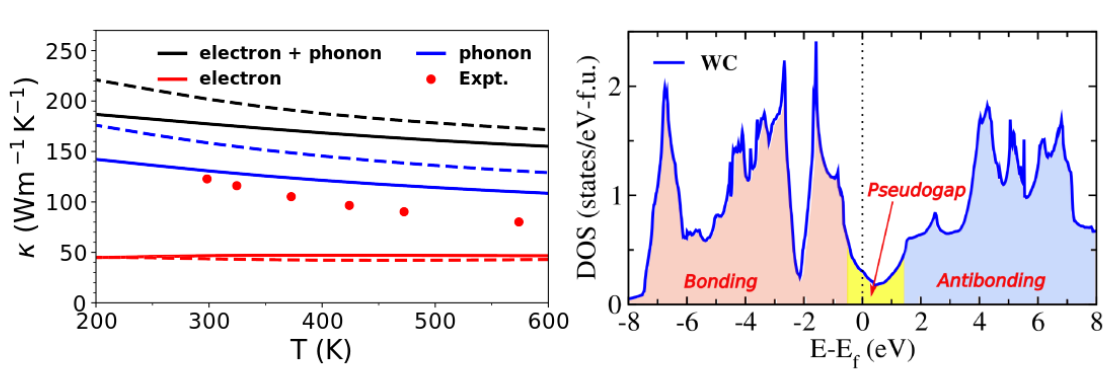Aided by first-principles techniques, phonon transport, a multidisciplinary field relevant to several industrial applications and of great importance to fundamental research, has been developing rapidly in recent years. However, the research on phonon thermal transport was mostly limited to non-metallic materials such as semiconductors or insulators, and the transport of phonons in metals is rarely involved. This is because it is generally believed that in metals (1) the thermal conductivity contributed by phonons at any temperature is negligible, and electrons dominate the thermal conductivity; (2) except at extremely low temperatures, the phonon scattering caused by electron-phonon coupling, does not affect the phonon transport properties.
Since 2018, the first-principles calculations have discovered anomalous phonon transport phenomena different from these two conventions. 1) Professor Broido and collaborators of Boston College studied group-IV (Ti, Zr, Hf) and group-V (V, Nb, Ta) carbides [Phys. Rev. Lett. 121, 175901 (2018)]. The lattice thermal conductivity of Group-IV carbides reaches around 70 W/mK at room temperature. Although the lattice thermal conductivity of group-V carbides is only around 30 W/mK at room temperature, it shows abnormally weak temperature dependence due to electron-phonon scattering dominating over three-phonon scattering. 2) Li Wu's group found that the lattice thermal conductivity of tungsten reaches as high as 46 W/mK at room temperature, which is about one-third of the electronic thermal conductivity. Like in group-V carbides, the electron-phonon scattering dominates, resulting in lattice thermal conductivity almost unchanged in a relatively large temperature range [Phys. Rev. B 99, 020305 (Rapid Communication) (2019); npj Comput. Mater. 5, 98 (2019) https://ias.szu.edu.cn/info/1019/4475.htm].
Recently, Li Wu's group found that the lattice thermal conductivity of a group-VI carbide, tungsten carbide (WC), can be as high as 160 W/mK at room temperature, three times the electronic thermal conductivity and much higher than group-IV and V carbides and other group-VI carbides. In the isotopically pure sample, the lattice thermal conductivity will be increased to 250 W/m-K. Similar to group-V carbides, the electron-phonon scattering plays a dominant role, making the lattice thermal conductivity have an abnormally weak temperature dependence. The study found that the very different features of lattice thermal conductivity in different groups are correlated with their electronic structure. The group-IV and V carbides have the cubic NaCl structure. In group IV carbides, the Fermi level lies at the boundary between the bonding and anti-bonding states, with a very low density of states (pseudo-band gap). The group-V carbides have one more valence electron, and this valence electron is thus anti-bonding. Additionally, the Fermi level falls away from the pseudo-band gap, and the corresponding density of states is large. As a consequence, the interatomic interaction in group-V carbides is small, resulting in lower frequencies for acoustics phonons. The optical phonons are dominated by the carbon-carbon atoms, and thus have frequencies similar to the group-IV carbides. As a result, a large frequency gap between acoustic and optical phonon modes is observed in group-V carbides. This large gap causes a weaker phonon-phonon scattering. At the same time, a large density of states leads to a larger electron-phonon scattering than the group-IV carbides.
As for group-VI carbides, they have different crystal structures (hexagonal structure). Although they have two more valence electrons than group-IV carbides, they are all in the bonding state. Similar to group-IV carbides, the Fermi level falls in the pseudo-band gap in the electronic density of states resulting in a stronger interatomic interaction than group-IV and V carbides. In WC, the mass of the W atom is relatively large, resulting in a large frequency gap between acoustic and optical phonon modes, which suppresses the phonon-phonon scattering. Further the larger interatomic interaction leads to smaller phonon-phonon scattering than the group-V carbides. The pseudo-band gap at the Fermi level also leads to a smaller electron-phonon scattering than the group-V carbides. The weak phonon-phonon and electron-phonon scattering together explains the high lattice thermal conductivity in WC.
To demonstrate the uniqueness of WC, another group-VI carbide, MoC, was investigated. The strong interatomic interaction and smaller atomic mass ratio lead to high frequencies for acoustic phonons. The small gap between the acoustics and optical phonons is not sufficient to suppress phonon-phonon scattering. As a result, the lattice thermal conductivity is only 50 W/mK at room temperature.

(Figure: Calculated thermal conductivity of WC (left) and the electronic density of states (right))
This work was published in Materials Today Physics 13, 100214 (2020), entitled "Anomalously large lattice thermal conductivity in metallic tungsten carbide and its origin in the electronic structure". The first author of the paper is Dr. Ashis Kundu, and collaborators include Dr. Ma Jinlong (now working at Huazhong University of Science and Technology), Dr. J. Carrete and Prof. G. Madsen of Vienna University of Technology. The research was supported by the National Natural Science Foundation of China and Shenzhen Science and Technology Commission.
Prof. Li Wu has been engaged in the research of phonon transport since 2008. He has developed the open-source software ShengBTE with collaborators (cited by more than 800 times and widely used by hundreds of research groups around the world), which makes the parameter-free first-principles techniques become the mainstream.
Paper link:
https://www.sciencedirect.com/science/article/pii/S2542529320300389


